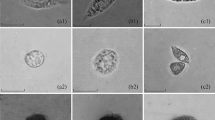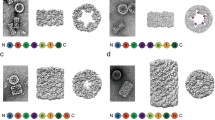Abstract.
Cytobiological experiments using isotopic- and cytochemical-labeled Sepia hemocyanin as well as immunocytochemical localization of the respiratory pigment were carried out to investigate the function of the hemocytes in hemocyanin metabolism of the common cuttlefish Sepia officinalis. For comparison, the rhogocytes (ovoid cells) of the branchial heart complex were included in this study. Hemocyanin molecules were immunocytochemically detected in the lysosomal compartment of the rhogocytes and, at lower levels, in adhesive and circulating hemocytes. 125I-labeled Sepia hemocyanin was taken up by the rhogocytes only, whereas gold- and/or fluorescein-labeled Sepia hemocyanin was solely taken up by the adhesive and the circulating hemocytes, even though the level of uptake is different. There are also differences in the uptake of pure gold particles and/or fluorescein between rhogocytes and hemocytes. These findings give evidence that circulating and adhesive hemocytes of the branchial heart complex are not involved in hemocyanin turnover, but are a component of the cellular defense and detoxification system of adult coleoid cephalopods.
Similar content being viewed by others
Author information
Authors and Affiliations
Additional information
Electronic Publication
Rights and permissions
About this article
Cite this article
Beuerlein, K., Ruth, P., Westermann, B. et al. Hemocyanin and the branchial heart complex of Sepia officinalis: are the hemocytes involved in hemocyanin metabolism of coleoid cephalopods?. Cell Tissue Res 310, 373–381 (2002). https://doi.org/10.1007/s00441-002-0642-8
Received:
Accepted:
Issue Date:
DOI: https://doi.org/10.1007/s00441-002-0642-8




